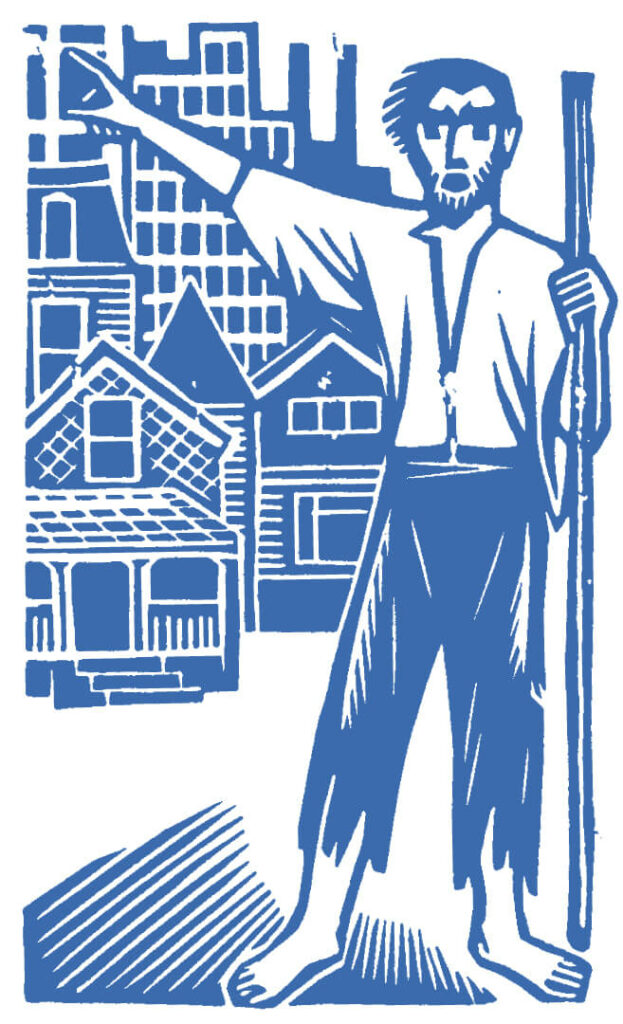
The fourth gospel begins in God time and enters history only in verse six, when “a man named John was sent from God…to testify to the light, so that all might believe through him” (1.6-7). Jesus has no birth story and no parents at the beginning of this gospel. Instead he has a dedicated public relations man who testifies someone greater is coming.
John the Baptist apparently preaches in such a compelling way that many mistake him for the promised messiah, but he insists he is not. Someone greater is coming who will baptize with the Spirit. Artfully the fourth gospel uses the Baptist to build up anticipation. The Baptist is the point man. Artists often draw him pointing.
The Baptist witnesses that indeed Wisdom, God’s partner in creation, has found a dwelling in Israel. The Word has taken flesh to reveal God among us. None of the four gospels can tell Jesus’ story without first introducing John the Baptist.
- Who has pointed to you as John did to Jesus? Whose story do you have to tell in order to tell your own?
Theology is faith seeking understanding. Christology is faith in Jesus, seeking to understand who he is, and his purposes for us. Christologies grow out of the inexhaustible resources we draw from the Old Testament, the gospels, and our experience.
Sunday’s short gospel describes who Jesus is from three Old Testament starting points—the Passover lamb, God’s chosen servant, and the Word who was with God from the beginning.
First the lamb metaphor. It has deep roots in Jewish life but ambiguous connotations for people today. We no longer make animal offerings to God.
When God sends Moses to set the Hebrews free from slavery in Egypt, the slaves must kill a lamb and put its blood on their doorposts to save their firstborn from the tenth plague, the killing of every first born. This is the plague that convinces Pharaoh to set the Hebrews free.
Attention to details in John’s gospel shows the evangelist compares Jesus specifically to the Passover lamb. In John 19.14, the evangelist carefully notes the time when Pilate hands Jesus over to the crowd who insist he be crucified. It is noon on the day of preparation before the Passover feast, the exact time the priests begin slaughtering the lambs families eat during the Passover meal.
Later, in John 19.32-33, soldiers come to break the legs of Jesus and the two others crucified with him, so that they will die before Passover begins. The soldiers find Jesus already dead, so they pierce his side to make sure but do not break a bone. This detail suggests Exodus 12.46, which tells those who prepare the Passover lamb not to break any of its bones.
This is not the lamb of sin offerings later in the temple. The Passover lamb symbolizes God’s deliverance of an enslaved people.
Israelites ever after eat the Passover lamb to remember how God delivered them. The Passover lamb becomes the food of the free at each Passover meal. Like the blood of the lamb, Jesus’ life frees people from slavery and death.
- How does identifying Jesus with the Passover lamb help you understand who Jesus is?
Second, the Baptist identifies Jesus as God’s chosen one. This title alludes to the prophetic writing of Second Isaiah, who writes four songs describing the exiled people of Israel as God’s suffering servant. One of the songs is Sunday’s first reading.
Isaiah gives the exiled people heart, insisting their suffering will heal others (Isaiah 53). He comforts the people and preaches that God forgives their faithlessness and disregard for people in poverty. He announces God will lead them home.
Isaiah sees the exiles as servants of God, specially chosen for making God known among their captors. The captives’ return from exile leaves a permanent mark in Israel’s history and becomes a frequent reason for praise in the psalms.
- From whose suffering do you carry lasting wounds and/or lasting hope?
- How does identifying Jesus with God’s servant people help you understand who he is?

Third, John’s gospel identifies Jesus as the pre-existent Word, “After me,” says John the Baptist, “comes a man who ranks ahead of me because he was before me.” This paradoxical verse echoes the opening verses of the John’s gospel, which describe the Word who was with God from the beginning.
This image of the Word borrows from the Old Testament description of Wisdom, who is personified as a woman.
The opening prayer in this issue parallels verses from Proverbs 8 that describe Wisdom and verses from John that describe Jesus as Word. Both Wisdom and Word are with God from the beginning, helping create and order all that is. “Wisdom pervades and penetrates all things, for she is the breath of the power of God … a spotless mirror of the working of God” (Wisdom 7.24-26).
Awe is the beginning of wisdom in the bible. Wisdom results from our human capacity to discover God’s handiwork in creation, its order, its fruitfulness, and beauty. Our minds perceived God’s activity, learn and teach about God by interacting with creation and appreciating life.
In the Baptist’s testimony, the evangelist John applies the personification of Wisdom to Jesus. Wisdom becomes the Word—“The Word became flesh and dwelt among us” (1.14). In his humanity Jesus reveals God as creation reveals God in its workings.
Like Wisdom, the Word comes from above and was from the beginning. Like Wisdom, Jesus brings the gifts of creation in abundance among the people—the best wine, living water, and living bread, the signs in John’s gospel.
Twice in Sunday’s short gospel John the Baptist insists that he did not recognize in Jesus the one greater whom he is expecting, not until the Spirit rests upon Jesus. Jesus is the one from above who will baptize with God’s own Spirit. This gospel articulates lavishly who Jesus is by echoing Old Testament images—the Passover lamb, God’s chosen servant, pre-existent Word, and in addition, Spirit-filled leader.
- What insights into who Jesus is does the Wisdom imagery give you?
- What contemporary imagery or philosophy might you draw on to express who Jesus is for us in our time?
